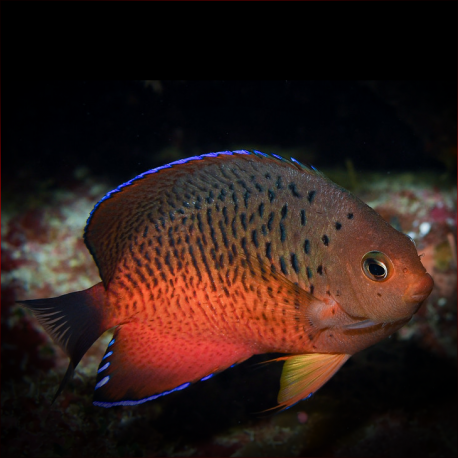More info
Datasheet
| Minimum Tank Size | 200 litres / 52.83 US gallons |
| Maximum Size | 10.0cm / 3.94inches |
| Reef Compatible | Reef safe with luck |
| Temperament | Mostly peaceful but might be aggressive towards similar species |
| Temperature | 22.2°C / 71.96°F - 25.6°C / 78.08°F |
| Specific Gravity | 1.020-1.025 |
| Carbonate Hardness | 8-12 |
| pH | 8.1-8.4 |
General DescriptionThe Rusty Angelfish, belonging to the Pomacanthidae family and the Centropyge genus, is known for its vibrant colors, making it a popular choice for aquarium enthusiasts. Typically growing to sizes around 10 cm, although some individuals can reach up to 18 cm, these fish add visual appeal to aquariums.
Aquarium SuitabilityConsidered suitable for aquariums, especially for those with an interest in keeping colorful and visually stunning fish. However, caution is advised due to their tendency to disturb certain corals like LPS and Zoanthus. It is recommended to carefully select tank mates and corals to ensure a harmonious environment in the tank.
Demands, Care, and HardinessDemonstrating hardiness, Rusty Angelfish can adapt well to aquarium conditions if provided with ample hiding spots among live rocks. They thrive in well-established tanks with algae-rich environments. These fish are mostly peaceful but can display aggression towards similar species, necessitating thoughtful species selection and tank management.
Reef SuitabilityConsidered somewhat reef-safe with luck, Rusty Angelfish may pose a risk to certain corals due to their feeding habits. They typically feed on microalgae and detritus, occasionally nibbling on coral mucus, which can be detrimental to some coral species.
Aquarium SetupFor an aquarium housing Rusty Angelfish, it is recommended to provide hiding spots within live rocks. Keeping the tank well-established with ample algae growth is crucial, as they graze on algae from rocks and stones. Offering a varied diet that includes microalgae such as spirulina is essential for their health and well-being.
BehaviourRusty Angelfish are known to be mostly peaceful but may exhibit territorial behavior, especially towards similar species. Providing adequate space and hiding places can help mitigate potential conflicts in the tank.
Feeding and DietTheir diet typically includes microalgae, detritus, and small crustaceans like mysis and artemia. Offering supplementary food rich in algae, such as spirulina, ensures a balanced diet for these fish.
DimorphismThese species can change gender from female to male, with females transitioning to males when the need arises. Captive breeding of Rusty Angelfish is feasible, making them a potential addition to breeding programs for aquarium enthusiasts.
Habitat and DistributionRusty Angelfish are native to the Western Pacific region, specifically ranging from Tanabe Bay in southern Japan to the southwestern tip of Taiwan and the Philippines. In the wild, they inhabit coral reefs and rocky areas, showcasing their affinity for well-structured environments.

